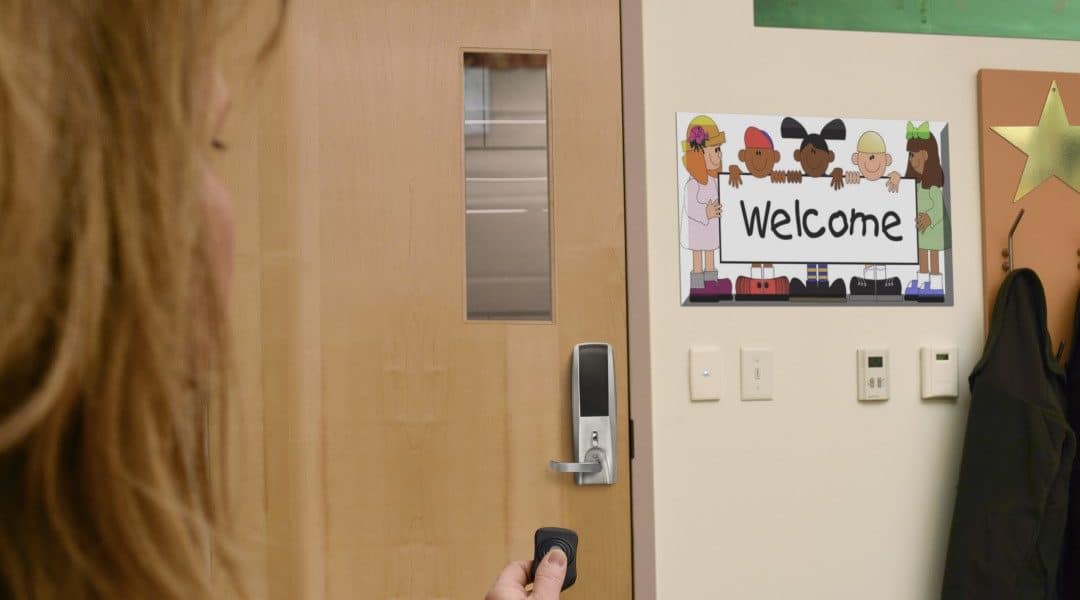By Ron Baer
Perimeter fencing, visitor entry vestibules, attack resistant doors, proper locks, secure key systems, and effective hardware all play an important role in a school’s Active Assailant Strategy including their lockdown policies and procedures. Each element must be carefully considered to ensure the safety of students, faculty, staff and extended campus users.
While lockdown procedures and drills have been an integral part of K-12 school safety plans in the past decade, they are continually being re-evaluated due to the many variables that can impact their effectiveness.
From school layout to staffing to training capabilities, every school has unique characteristics that must be factored into their lockdown protocol. The policies and procedures must then be tested through lockdown drills to identify gaps and ensure faculty, staff and students know exactly what to do in an emergency situation.
The safety strategy promoted by the Department of Homeland Security (DHS), the National Education Association (NEA), most security consultants and first responders is to evacuate whenever possible, suggesting that the further away from the event, the higher chances are for survival.
This strategy could be best understood by comparing the protocol for a fire vs. hurricane. In the case of a fire, proper planning and situational awareness dictates the path to safety, away from a fire. The top priority is to evacuate and get far away from the danger. If the fire is outside the door, or blocking the path of egress, situational awareness may ultimately dictate that it is better to secure the occupied room and await the first responders (Lockdown).
In a hurricane, the recommended procedure is to proceed to a predetermined secure area until the threat passes (Shelter-in-Place). Shelter-in-Place is also used in many bomb-threat strategies to help facilitate the safe and efficient search, without the complexities of closing the school.
How Lockdown Decisions Are Made and Applied
In every scenario, there should be a protocol that incorporates a specific method of lockdown based on how and where decisions are made and applied.
Traditionally, there are two types of lockdown: Centralized Decision with Universal Application and Decentralized Decision with Local Application.
Centralized Decision with Universal Application occurs when a decision is being made from a single location to lock all doors campus-wide with the push of a single button. This approach lacks situational awareness in each classroom and corridor.
Thus, security and law enforcement professionals are now consistently advising that this approach can actually escalate risks through unintended consequences. Substantial unintended lockouts can occur during passing periods, lunch times, project-centered learning activities, as well as before and after school.
Decentralized Decision with Local Application allows each teacher to decide whether to evacuate or lock their own door, based on their situational awareness and options.
There are pros and cons to this type of lockdown, as well. The main benefit is that it allows teachers to make an intelligent decision based on their direct surroundings and situation.
Security professionals will most often suggest an application-appropriate solution or hybrid of these two lockdown options, which many law enforcement and first responders also advise.
Many times, this includes a Centralized Decision with Universal Application along the perimeter of a building and property, combined with a Decentralized Decision with Local Application for interior doors that allow teachers and faculty to respond to events.
Collaboration and Consensus
The best Active Assailant Strategies including lockdown policies and procedures are designed when many people are included in the planning. Church (host) and school administration, teachers, students, parents, first responders, support organizations, the school board, architects, designers and consultants all have roles to play.
Administrators must involve everyone to make the best decisions and have the greatest chance for successful execution of their lockdown policies and procedures.
Possibly the most important component in executing an effective school lockdown is having an administration committed to ensuring faculty and staff have the training they need to respond appropriately in an emergency situation.
A well-planned response needs to be communicated and practiced through routine drills, just like fire drills, to ensure there is less panic and confusion in the event of a real lockdown.
If protocol calls for a teacher or staff member to make a local decision, they must also be empowered to use their judgment to best protect their students, without the fear of disciplinary action after the fact
When developing a lockdown plan teachers and staff input is essential because they have unique insight into the logistics of their classrooms.
For example, many educators secure their personal items in a cabinet or drawer and may not have immediate access to keys or access control credentials. In order to implement a proper lockdown procedure, this policy would be changed so teachers keep their credentials or keys on them at all times.
Selecting the Best Lockdown Solution
Deploying the appropriate technology for lockdowns is imperative and a solution must be selected carefully. All of the previously discussed factors must be considered, in addition to budget and structural limitations.
Once faculty and staff are informed of a lockdown, the first step is usually to lock all doors and windows immediately. How they go about doing so depends entirely on the door hardware and lockdown technology implemented at their school.
The following options exist for securing school doors and entryways:
Mechanical Locks
Functionally, a mechanical system is well-proven technology that’s stood the test of time. Various options are available (mortise and cylindrical locks, exit devices, deadbolts), which can be locked from the inside with a key. The major drawback in school lockdowns is that teachers must locate their keys, get to the door and be able to quickly operate the hardware while under enormous pressure.
Other options to secure the door from the inside (thumbturns, pushbuttons) are much easier to use in a high stress situation (over a key). Locks are also available that always remain locked from the outside, requiring a key to open the door (storeroom function). This eliminates the complications of locking the door in an emergency, but can be disruptive during normal times.
Standalone Locks with RF Fob
A fob communicates through radio frequency to lock the door from anywhere in the classroom and eliminates the need to walk to the door to lock it. If a teacher receives a text alert or an audible lockdown alert, the teacher can lock the door from where they are. Since fobs communicate on a radio frequency, the system must be tested and maintained to avoid interference issues that could arise in a lockdown.
Offline or Data-on-Card Locks
These locks add the benefits of a low-cost, easily managed card access for classrooms and offices, with the storeroom mechanical functionality mentioned above.
Wi-Fi Locks
To prevent intruder access to Wi-Fi locks, teachers can walk to the door and push a button to turn the reader off, or set them to block lower-level credentials. Since Wi-Fi locks are normally in locked mode, they do not need to be locked down.
However, they are capable of maintaining an extended unlocked/passage mode, in which case there would be a delay in executing a Centralized Decision lockdown scenario. To shorten the delay time, a Wi-Fi lock can be hard powered, increasing the frequency in which it communicates. The Wi-Fi lock maintains its local functionality in the event of a power or network outage and numerous integrations allow the lock to function with many software platforms, linking multiple security functions.
Aperio
This smart technology eliminates the greatest cost and complexity of traditional access control – the wiring around the door – by using wireless communication between the Aperio wireless device and a hub that is connected to an access control panel.
Aperio appeals to many schools because it offers the flexibility and convenience of wireless with the real-time communication of online access control. With the next generation of the Aperio wireless locks, Centralized Decision lockdown can be accomplished in less than 10 seconds.
In addition, Aperio technology is available in a range of locking devices that can address almost any application, including cabinets and drawers for even greater security in areas like the nurse’s office or records storage.
Hardwired
Doors can be hardwired allowing for an instantaneous Centralized Decision lockdown and a plethora of door hardware options. Backup power supplies and supplemental locking options may be incorporated to mitigate a power and/or communication outage.
Many times, hardwiring doors is initially the first choice for schools, but it frequently exceeds school budgets once construction begins since it involves wiring, power infrastructure, and panels installed in a closet.
Late-stage value engineering often results in the elimination of all or most of a traditional hardwired access control system. Power over Ethernet (PoE) lock options give the same functionality as traditional hardwired locks, but offer significant infrastructure cost savings in new construction. Incorporating lower cost wireless and stand-alone options can help prevent security compromises, due to budget constraints.
Prepared for Any Situation
New security innovations help accommodate lockdowns and keep students safe inside the classroom. Technology and automation have greatly improved lockdown capabilities and opened up new, more flexible lockdown options that allow school administrators to adjust their response based on individual scenarios.
The right lockdown solution combined with a well-thought-out plan and training through routine drills can make all the difference in a crisis situation.
In an emergency, people often panic and fail to perform simple tasks, making drills imperative to ensuring teachers and staff feel confident implementing a lockdown.
Teachers and staff should be given ample practice at physically locking doors prior to a crisis and any issues should be addressed through further training.
Proper planning and correctly deployed technology can mean the difference in averting the kind of crisis and tragedies that rightfully concern every school today.
Ron Baer is director of business development – K-12 at ASSA ABLOY, www.assaabloy.com.






